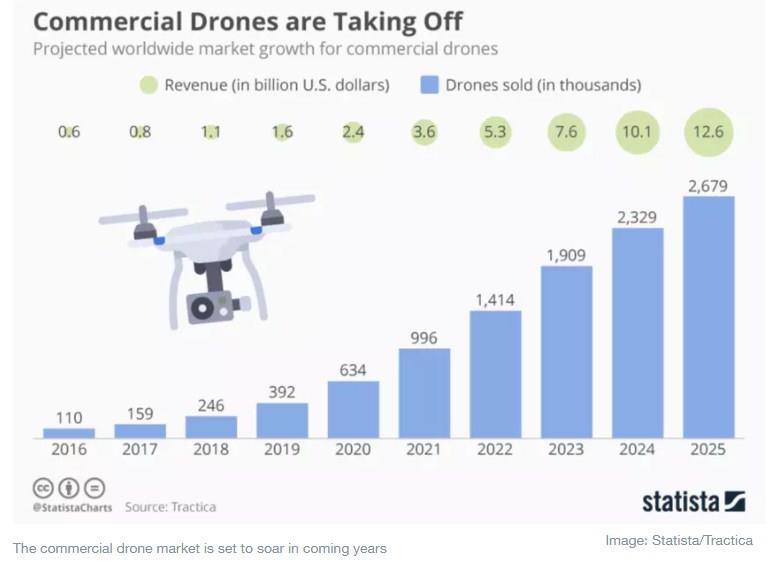by Harrison Wolf*
With the announcement a few days ago that Amazon’s drone delivery programme has been approved in the US, the continued innovation race for consumer package delivery is on.
Amazon is the third company to achieve this unique milestone from the Federal Aviation Administration (FAA) enabling expanded use of their autonomous air delivery system to connect rural populations for improved delivery times.
While Alphabet’s (the parent company of Google) wholly owned drone delivery service Wing Aviation and UPS’ Flight Forward have both already achieved this certification, Amazon’s long-expected approval trailblazes with a business model that potentially integrates seamlessly into existing logistics systems.
Including drone delivery into Amazon services to create a 30-minute-or-less delivery option via Prime Air provides the clearest picture for drone delivery to-date and has significant competitive advantages over the other two approved operations. While innovative start-ups like Zipline and Wingcopter are leaders in the drone revolution outside the US – both with successful operations throughout Africa and Europe – Amazon, Google and UPS are set to redefine the landscape of delivery more broadly.
Though Google and UPS beat Amazon to this milestone, successful drone delivery has proven over the past few years to be less about the technology and more about how the drones are used. Zipline, the San Francisco-based drone delivery company that redefined what is possible using drones in Rwanda and Ghana by delivering blood and PPE, always highlights that it is a logistics company first, and a drone business second. Its most important innovations come through supply chain management, integration with existing workflows, and continued education of their stakeholders in the process.
The following three distinctions between the leading companies in the US offer insights into who will win the race for delivery domination.
1. Who builds the drones?
Amazon and Google build their own drones, UPS doesn’t. Choosing to build your own drone is risky. Hardware, as they say in Silicon Valley, is hard. Amazon and Google, both tech companies at heart, have developed their own hardware from the beginning and continue to develop and attempt to certify their aircraft internally, creating tighter innovation processes and quicker evolution.
They also continue to develop the connective technologies that will maintain and manage their operation. This has the benefit of allowing exactly the type of aircraft changes they need, ensuring streamlined development processes and rapid evolution to meet their needs.
UPS, on the other hand, has found value in partnering with innovative start-ups in which they have invested such as Matternet, Wingcopter and Zipline. By partnering, they have been able to reduce their risk exposure, influence design through adoption, and focus on what they do best: meeting the needs of their customers. While UPS will be reliant on portfolio companies to perform and achieve certifications, treating a drone like a truck to optimize how it is used may be the right play.

2. Is there an existing logistics network?
UPS and Amazon have huge logistics networks and existing demand; Google doesn’t. Every product needs a customer. UPS and Amazon are their own customers when it comes to drone delivery. Google, on the other hand, needs to partner with businesses outside of the standard Amazon or UPS delivery network for drone delivery.
The real question is whether you would rather be a supply-chain company looking to integrate a technology or a tech company looking to create and refine one piece of an entire logistics network. To-date, Google’s delivery network has focused on tests with small businesses – most notably burritos and dog food delivery in Australia, baked goods in Finland, and more recently groceries in the United States.
UPS, on the other hand, has applied its logistics expertise in delivering prescription medicines to elderly communities in Florida while their partners look to certify their systems. Amazon, having missed an opportunity to pilot real business operations in the US through the FAA’s initial Unmanned Aircraft System (UAS)Integration Pilot Programme (IPP), has had very limited operational testing with customers though they have been able to test on-demand delivery of goods in Cambridge, UK.
3. What’s the tech X-Factor?
The X-Factor: All three major players in the drone delivery race in the US have real differentiators when it comes to technology. Wing, having been spun out of the Google X lab, can leverage close partnership to any of Google’s other products, including high resolution mapping, autonomous technologies, health-sensor data, and a plethora of other lesser unknown or in-development technologies that can act as catalysts for rapid change or application.
Amazon’s clear understanding and domination of e-commerce – from product development to consumer behaviour to delivery – may be just the thing that sets them apart. UPS’ global experience in supply-chain and logistics management, combined with trust from both consumers and government, may provide the wisdom and character needed to promote the societal acceptance needed.
Three behemoths of technology and delivery are asserting their place in the sky above our heads like never before. Who will win the race? Will it be the tech giant experts at Google with a grab bag of technologies set to support and accelerate their drone vision? Will it be UPS, the traditional supply-chain and logistics delivery company already trusted to handle other companies’ most important goods? Or will it be Amazon’s Prime Air, a combination of the two, with an existing customer base more familiar with technology and eager to receive packages ever faster?
Only time will tell, but one thing is for sure: the drone delivery revolution has begun.
*Project Lead, Aerospace and Drones, World Economic Forum
**first published in: www.forbes.com




 By: N. Peter Kramer
By: N. Peter Kramer

